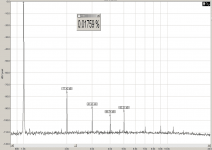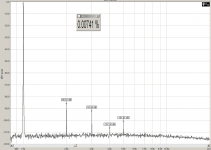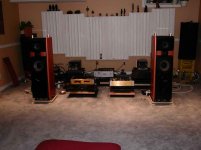Why could class D have even MORE details than class AB? The latter have high BW and SR capable of delivering 20KHz square wave without distortion; while class D (with output LPF) never can do.
(though I think there's some other places that class D could sound better than class AB.)
(though I think there's some other places that class D could sound better than class AB.)
Lazyworm,
Everyone here well know about flat THD/FREQ plot of the any UcD's. 😎
PS: please note, that UcD loop gain just around 30db, far from AB measured by you. Aha? 🙂 So if someone add 30db else to be comparable D with AB, would be really hard to measure it, for DIYer at least. BTW, I try it at moment.. fascinating process.
BTW, I try it at moment.. fascinating process.
Everyone here well know about flat THD/FREQ plot of the any UcD's. 😎
PS: please note, that UcD loop gain just around 30db, far from AB measured by you. Aha? 🙂 So if someone add 30db else to be comparable D with AB, would be really hard to measure it, for DIYer at least.
 BTW, I try it at moment.. fascinating process.
BTW, I try it at moment.. fascinating process.
Jan-Peter,Jan-Peter said:
Please check these measurment, power versus THD.
Regards,
Jan-Peter
Could you throw us some FFT plot like I was asking at UCD180 thread?
FFT plot for example at 1khz and 1/10 (+1/2) power? I am curious about spectral distribution of distortion components in these...
Regards,
Matti
mzzj,
I've measured UcD400 in the same conditions: 8Ohm, 1khz -10db, -3db for two position of the "bias" pot (factory/>factory), so there 4 pics, i think later i'll post here. E.g. -10, factory, 2=-86.61db, 3=-92.94db,4=-107.36db, 5=-101.81 the others is lower then noise floor -110-115db in the my setup.
I've measured UcD400 in the same conditions: 8Ohm, 1khz -10db, -3db for two position of the "bias" pot (factory/>factory), so there 4 pics, i think later i'll post here. E.g. -10, factory, 2=-86.61db, 3=-92.94db,4=-107.36db, 5=-101.81 the others is lower then noise floor -110-115db in the my setup.
Thanks, looks as I expected. IF i remember correctly Bruno was saying that UCD is not engineered for minimum distortion but compromise between "sounding good" and measurements results. Rather high amoung of 2nd harmonic might be the trick...IVX said:mzzj,
I've measured UcD400 in the same conditions: 8Ohm, 1khz -10db, -3db for two position of the "bias" pot (factory/>factory), so there 4 pics, i think later i'll post here. E.g. -10, factory, 2=-86.61db, 3=-92.94db,4=-107.36db, 5=-101.81 the others is lower then noise floor -110-115db in the my setup.
soongsc said:
How much do the UCDs differ from the Tripaths?
It depends how you use them, if I compare my AMP1B to the UCD's, the UCD's have more authority till insane levels.
Very,very balanced although the AMP1B gives the impression of being more open at low levels, the moment you up the level to whatever they stay absolutely balanced as where the AMP1B will become harsh sounding, a bit like class AB(no pun intended Carlosfm).
Bgt said:
It depends how you use them, if I compare my AMP1B to the UCD's, the UCD's have more authority till insane levels.
Very,very balanced although the AMP1B gives the impression of being more open at low levels, the moment you up the level to whatever they stay absolutely balanced as where the AMP1B will become harsh sounding, a bit like class AB(no pun intended Carlosfm).
What kind of power supplies are used in the UCDs and AMP1B?
tomahack said:I built two monoblocks using UcD400's . Comparing them with the best class A or AB can offer is to say the least unfair. They don't even come close. By comparaison, a Bryston 4BSST sounds anemic, muddy and filled with helium. I drive them directly from my Cary 303-300.
I was a sceptic. I'm now a beleiver.
An externally hosted image should be here but it was not working when we last tested it.
Short signal path, good input buffers (IF needed), good PSU are very importand for the final result.
Does the Bryston have all that?
You are comparing completely different things.
Most of the times the problem is not on the final amplification stage, it is before it.
You can make an LM3886 power amp, keep the sinal path as small and direct as possible, good grounding arrangement, good PSU and you can beat a Krell in every respect (except output power).
Mine does.
Easily.
More detail, 'air', dynamics 😱 , tighter bass, natural harmonics and decays that the Krell can only dream of.
This is comparing to a KAV-300iL, used as a power amp.
Because the (standard) preamp seccion is too bad to be true.
soongsc said:
What kind of power supplies are used in the UCDs and AMP1B?
The UCD has a toroid of 225VA, normal bridge rectifiers(1 for 1 amp), 2x10000uf for 1 amp while the AMP1B has an electronic transformer 150VA with schottky diodes in bridge mode(1) and 2x15000uf caps. Ucd has 87W/channel, the AMP1B: 58W/channel
carlosfm said:
Short signal path, good input buffers (IF needed), good PSU are very importand for the final result.
Does the Bryston have all that?
You are comparing completely different things.
Most of the times the problem is not on the final amplification stage, it is before it.
You can make an LM3886 power amp, keep the sinal path as small and direct as possible, good grounding arrangement, good PSU and you can beat a Krell in every respect (except output power).
Mine does.
Easily.
More detail, 'air', dynamics 😱 , tighter bass, natural harmonics and decays that the Krell can only dream of.
This is comparing to a KAV-300iL, used as a power amp.
Because the (standard) preamp seccion is too bad to be true.
Ok, what If I said that since switching amplifiers amplify the signal via modulation, their signal path is as short as the input stage comparator inputs, it "ends" there in the strict analog sense. It still passes through many active components but they're all working like switches. That introduces problems of its own which mostly have been solved simply by using self oscillating techniques which automagically include the non idealities into the control loop.
There's other ways you can do that but non so simple, and seems a trend has been set because simplest is always best, and this case is no exception.
Now what you've done is removed the sound of every single active component past the input stage, I know that's frightening to some, because that's what other amps can't do, ever.
Your sound then demodulates through the output filter, which is included in a global feedback loop that controls the self oscillating/error correction. Left over ripple is not to be feared because it's of very low power (in good designs), well out of the audible range, and also you're that of your speakers time constant.... it couldnt' possibly responde do it. That just scratches the surface, but only the sound of the passives will matter.
......
Shouldn't Bryston have all that? Thought they were pro audio at its best.
Member
Joined 2002
tomahack said:I built two monoblocks using UcD400's . Comparing them with the best class A or AB can offer is to say the least unfair. They don't even come close. By comparaison, a Bryston 4BSST sounds anemic, muddy and filled with helium. I drive them directly from my Cary 303-300.
I was a sceptic. I'm now a beleiver.
An externally hosted image should be here but it was not working when we last tested it.
How much canadian did you pay for the one class d moduel ?
jleaman said:
How much canadian did you pay for the one class d moduel ?
Ask Ken. Cheaper than Adire.
http://www.digitalanaloguediy.com/
classd4sure said:Shouldn't Bryston have all that? Thought they were pro audio at its best.
Why should it?
I've heard too many reputed and $$$ gear that didn't impressed me at all.
Like (big) Classé monoblocs, for instance.
I didn't hear that Briston though, so I can't comment.
carlosfm said:
Why should it?
I've heard too many reputed and $$$ gear that didn't impressed me at all.
Like (big) Classé monoblocs, for instance.
I didn't hear that Briston though, so I can't comment.
Well because Bryston as far as I know they're considered upper end of the pro audio scale. What does that mean to me? Same as it does to you, nothing. If we however assume they built the name through making good amplifiers over marketing tactics, we can assume they've taken those basic steps appropriatly with as little compromise as possible.
I'm sure they made compromises like anyone else, but I think if you got to hear one next to a UCD for example, and found you didn't like the Bryston at all, would you really be ready to blame an inferior layout? That's pretty basic stuff isn't it?
I haven't heard that Bryston or even a Hypex module yet either 🙂
Too bad you didn't have the time to try a homebrew class d amp just for the experience of it.
Member
Joined 2002
How about this stereo.. This guy has invested more money into this stereo setup than most would pay for there whole house..
more pictures at
http://jleaman.ath.cx/Alec
more pictures at
http://jleaman.ath.cx/Alec
Attachments
classd4sure said:I'm sure they made compromises like anyone else, but I think if you got to hear one next to a UCD for example, and found you didn't like the Bryston at all, would you really be ready to blame an inferior layout? That's pretty basic stuff isn't it?
No, I would have to open it, if possible.
I see bad things and bad ways to do it inside most gear, irrespective of price.
Krell also made a name, but not all is good, as in everywhere else.
classd4sure said:Too bad you didn't have the time to try a homebrew class d amp just for the experience of it.
Maybe I will, I didn't say I won't.
One thing is for certain: there's always room for improvements, and I would not sit quiet. 😀
So... it's not just a case of assembling the amp.
Meanwhile, I'm building (again) a phono pre. Sold mine.
Working on a CDP.
Making a pair of 3-way speakers.
Charging 4x12V/24A batteries for some tests I have in mind...
This is all rolling in simultaneous right now. And I have my job...
Hey, I need some time. 😀
- Status
- Not open for further replies.
- Home
- Amplifiers
- Class D
- If you think Class D is not HiFi...you are fool




